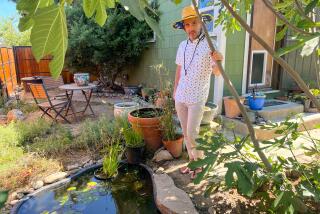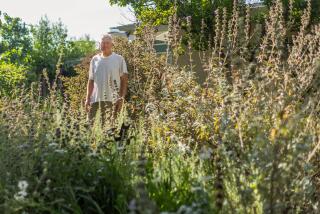STYLE : GARDENS : On Plastic Pond
- Share via
Born and raised uselessly urban in concrete mazes as far-flung as Boston, New Orleans, Frankfurt and, finally, Los Angeles, I only recently succumbed to the lure of the land. I now plant and prune and water and weed--things I swore I’d never do. Until recently, I had found dirt threatening. I feared the bugs in it, the primordialness of it, the “otherness.” More to the point probably, I feared my oneness with it, my connection to it, the fact that I’d be resting in it all too soon. As I age, though, I enjoy familiarizing myself with my future home.
It was not a small step from a garden to a pond. The Other Half grew up outdoors, in Northern California, near Mt. Shasta, swimming in natural lakes, walking through the woods --while I blared stereos to drown out the neighbors. The Other Half assured me there was an undeniable allure to water, an irresistible tug on the human heart and soul. To tell the truth, I had never heard of anything more outrageous. A pond?I imagined terra-cotta cherubs tinkling in a scallop shell.
But I soon found myself digging a 5-foot-by-4-foot-by-3-foot hole, thinking all the while: “With any luck, this nightmare will end here, and we’ll have the makings of a flower bed.”
The next stop was the hardware store where, lo and behold, they sell pond kits, do-it-yourself jobs for the novice. We didn’t buy one because the Other Half likes doing things “just so.” Our pond would be a natural pond, or as close to one as we could manage. We bought a pond liner, a large, thick piece of black plastic and laid it in the hole, an odd beginning for a “natural” pond, but I let that slide.
To disguise the black plastic liner, we thought of burying it under paving stones, but the cost was prohibitive. Then, one day, on a daily walk, the Other Half, always alert, noticed a rock-strewn ravine in the nearby hills. I returned home to find stacked outside our back door six large river rocks--the solution to all of our problems. I agreed to go back and fetch more.
Now we aren’t talking pebbles here, or stones. We are talking rocks,great, big, heavy, thundering rocks,incredibly huge boulders that I find myself dragging up the 100-foot, 45-degree incline of this earthly fissure. My legs are screeching at me. I can’t see for the sweat in my eyes. My arms throb. I’m about to drop an 80-pound rock on my foot, and my old AMC Hornet is now a lowrider. Finally, back in the car, I hear: “Are you angry with me?”
“It’s not you,” I reply, heaving. “It’s the rocks. I’m angry with the rocks.”
We drive home in silence and later enjoy the singular pleasure of hauling the rocks from the car to the back yard. It’s considered cruel to ask convicted felons to do this, yet here I stand, guilty of nothing, up to my knees in rocks.
Once the rocks have been artfully placed to represent an unstudied, rambling pond border--and to obscure the black polyurethane liner--we finally fill the pond with water. It looks rather fetching, so we trot off to the local nursery for advice on introducing aquatic life to this “natural” environment.
Along the way, I concede: “Maybe this pond thing wasn’t such a bad idea after all.”
“I told you so,” smugly chimes the Other Half.
At the nursery, we stare at the display pond until a portly fellow walks up to us. He looks like a humorless stand-up comic. We describe our new pond and ask what sort of plants would best suit it.
“Waterlilies,” he replies flatly.
Scanning the plant list, I stand mute with horror at the price, $35 a waterlily--an unnatural price for so natural a pond.
“What’s cheap?” I ask.
We choose the most attractive of the economical greens.
“You got fish?” he asks.
“Not yet.”
“You got a pump?”
“No.”
“Need a pump.”
“How much?” I ask.
“Sixty bucks.”
“Don’t want a pump.”
“You want fish?”
“Yeah.”
“Need a pump.”
We scoff and head to the fish store across the street. A woman in her 50s, with a magenta beehive and a dense cloud of cigarette smoke swirling around her head, glares at us as we enter. We explain that we want some goldfish for our pond.
“You got a pump?” she asks.
“Is there a school for this?” the Other Half mumbles to me.
“No,” I reply. “We don’t have a pump. We don’t want one.”
“Fish won’t live.”
“Half the kids in this country keep goldfish in a bowl,” the Other Half says.
“They die,” she replies.
“So will you,” taunts the Other Half, as I drag the two of us out the front door, “but your parents had you anyway. . . .”
Reliving our youths, we buy three goldfish at Woolworth’s. Having arranged the plants tastefully, we release the fish into their new home. They look happier.
One week later, two float belly up on the surface of the water, which resembles an oil slick and smells like a sewage-treatment plant. We head back to the local emporium and buy some chemicals that promise to eliminate problems like ours. We measure the chemicals precisely and add them to the water, which turns black.
Wrong chemical.
Up to our knees in pond scum, we drain the pond with a bucket. We refill the “natural” pond and add the proper chemicals. The next morning, the water level has dropped six inches. We’ve sprung a leak.
“Bury it!” screams the Other Half. “I hate that pond!”
Two weeks later, we started from scratch and did it right. So that others may learn from our mistakes, here’s the poop:
* There is little readily available information about garden ponds. Most books are underwritten by pond implement manufacturers and are therefore somewhat suspect. But I did find “The Rock and Water Garden Expert” by D.G. Hessayon from Sterling, which was both unbiased and affordable.
* Don’t cut corners on the padding for your pond liner. The liners are strong, but not impervious, and sharp rocks or roots can and will eventually tear them.
* You will need a pump to aerate your pond, and probably a filter if only to protect the pump. A good pump for a small pond should be about $60 tops; a suitable filter, less.
* Dechlorinate your water after filling the pond, stock the pond with plants and wait at least one week before adding fish. Add the fish no more than two at a time, at three-day intervals.
* Don’t overfeed your fish. Their waste will pollute the water and harm them. In summer, I feed our goldfish and inexpensive koi small amounts of food twice a day; in winter, the fish eat much less, so I reduce the amount of food accordingly.
* Pond plants must be cut back, transplanted, perhaps fed on occasion if they are to remain healthy and attractive. The selection is surprisingly varied, from statuesque papyrus to delicate parrot’s feather, water lettuce to duckweed.
After all the backaches and headaches, we now have a functional pond. The new plants and fish thrive. Bees, birds and lizards come to drink from it. Since the goldfish ate one of their brethren, I replaced them with two bold, colorful koi,which have increased pond activity tenfold.
The thing is glorious. I regularly spend hours skimming leaves from it, staring at it to glimpse the fish. As the plants grow and the dragonflies dip, I sit amazed at the amount of life inside and around it. I’m its gatekeeper. It’s my creation, and its capricious, remorseless beauty is a part of me and mine, yet grows beyond me every day.






